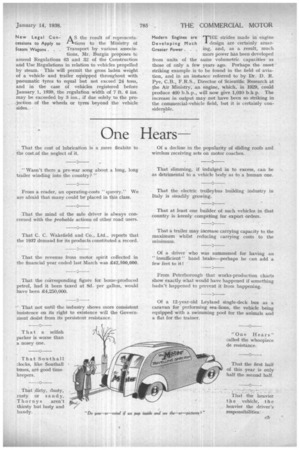Passing Comments
Page 2

Page 3

If you've noticed an error in this article please click here to report it so we can fix it.
I N view of the rapid progress of the trolleybus, it may be of interest to refer to the fact that it is only 11 years since the world's first six-wheeled double-decker of this type was put into service. To-day, nearly 2,000 of these vehicles are in use in 35 centres. Now the first has been withdrawn from service because the body is out of date, and has been placed in the Guy Museum. This vehicle has the regenerative-control system, which has been extensively adopted elsewhere, although originally severely criticized.
First Municipal Double-deck Trolleybus for Guy Museum Theoretical and A CONSIDERABLE amount Practical Research on of research on street light Street Lighting. ing has been carried out during 1937 by the General Electric Co., Ltd. Methods of theoretical and experimental investigation into the appearance and visibility of streets have been used in the study of the effects of mounting height, and of location of light sources. These have corroborated the design rules which had resulted from observation. A new method for studying experimentally the factors affecting the appearance of streets has been developed and has already yielded useful results in showing certain limits of design for both cut-off and non-cut-off distributions. The method involves the use of the simultaneous projection on to a single section of two standard
c4 representation lantern slides. Work has already been done on vision in streets under various sources of light, and the conclusion has been arrived at that no significant difference in seeing is traceable to the type of light source.
Which Is the Oldest A T various times informaCommercial Vehicle 1—ktion reaches us concerning
in Service veteran vehicles still in ser vice. It would be interesting to learn what concern possesses the oldest of such machines, whether it still be giving economical service, is in good mechanical order, and by what company it was manufactured.
Association's Simple THE London Association Form of Legal Defence I Section of the National
Scheme Road Transport Employers'
Federation has in operation an interesting scheme under which, for an annual payment of 5s. per vehicle, free legal defence is provided in respect of all offences which are dealt with at police courts. Every, five years the accumulated unexpended balance is returned to contributors in proportion' to their subscriptions; last year it was possible to reimburse them to the extent of about one-third.
New Legal ConAS the result of represents cessions to Apply to tions to the Ministry. of Steam Wagons. . Transport by various associa tions, Mr. Burgin proposes to amend Regulations 63 and 32 of the Construction and Use Regulations in relation to vehicles propelled by steam. This will permit the gross laden weight of a vehicle and trailer equipped throughout with pneumatic -tyres to equal but not exceed 24 tons, and in the case of vehicles registered before January 1, 1939, the regulation width of 7 ft. 6 ins. may be exceeded by 3 ins., if due solely to the projection of the wheels or tyres beyond the vehicle sides. •
THE strides made in engine design are certainly amazing, and, as a result, much more power has been developed from units of the same volumetric capacities as those of only a few year ago. Perhaps the most striking example is to be found in the field of aviation, and in an instance referred to by Dr. D. R. Pye, C.13., F.R.S., Director of Scientific Research at the Air Ministry, an engine, which, in 1929, could produce 469 b.h.p., will now give 1,010 blip. The increase in output may not have been so striking in the commercial-vehicle field, but it is certainly considerable.
Modern Engines are Developing Much Greater Power. .


































